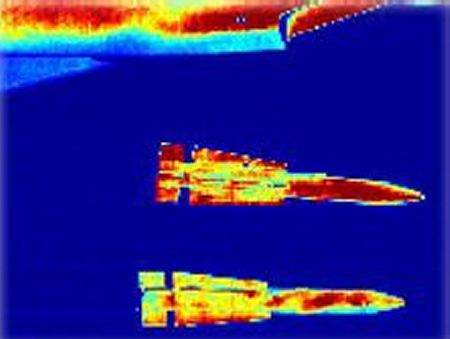|
||||||||||
|
|
||||||||||
|
||||||||||
|
|
||||||||||
|
|
|
|||||||||||||
|
As seen below, the PSP experimental setup is composed of a number of separate elements. The specifications of each
element are dependent upon the test conditions, objectives, and budget.

Typical PSP experimental setup [from Fundamentals]
Illumination:The illumination element ("light source") of the setup is used to excite the luminescent molecules in the PSP coating. Since the intensity of the emitted illumination is proportional to the excitation illumination, the source of illumination must be of sufficient power in the absorption spectrum of the PSP coating, and also have a stable output over time. For complex models with numerous surfaces, multiple illumination elements are often needed to achieve an adequate coverage of the model surface. Some examples of illumination elements are lasers, continuous and flash arc lamps, and simple incandescent lamps.
Imaging:The imaging element ("camera") used in the experimental setup is heavily dependent upon the required results. In most cases, a good spatial resolution of the pressure distribution is required. Imaging elements that can provide a good spatial resolution include conventional still photography, low-light video cameras, or scientific grade CCD cameras. In most PSP applications, the electronic CCD cameras are the preferred imaging element due to their good spatial resolution and capability to reduce the data they acquire in real time. CCD cameras can be divided into two groups, conventional black and white video cameras and scientific grade CCD digital cameras. Conventional black and white video cameras are attractive mainly due to their low cost. Typical cameras deliver an 8-bit intensity resolution over a 640 X 480 pixel spatial resolution. Even though conventional black and white video cameras are not precision scientific instruments, when coupled with a PC image processor, the results obtained are more than acceptable for qualitative analysis, and are potentially acceptable for quantitative analysis in certain conditions. Scientific grade cooled CCD digital cameras, on the other hand, are precision scientific instruments that provide high-precision measurements, at the price of an increased cost. Typical cameras of this type can exhibit 16-bit intensity resolution and spatial resolution up to 2048 X 2048 pixels. For many PSP applications, the high resolution provided by these cameras is mandatory.

Images taken of pressures on an AIM-54 Phoenix missile separating from an F-14 fighter
Optical Filters:In order to avoid erroneous illumination readings, it is necessary that the illumination element only output in the absorption spectrum, while the imaging element only records the emission spectrum. When lasers are used for excitation purposes, this is not an issue, as a laser only produces light in one wavelength. Most excitation sources, however, produce light in a wide spectrum. In order to prevent the excitation source spectrum from overlapping the emission spectrum, optical filters are placed over both the illumination element and the imaging element. This constraint also makes it necessary to conduct all PSP testing in a darkened test section, otherwise ambient light may contaminate the readings.
Data Acquisition & Post Processing:The data acquisition and post processing in most PSP applications is done in a modular fashion. Initially the camera and computer acquire images for wind-on and wind-off conditions. These images can then be corrected and processed as necessary, either on the same or different machine. This modular approach provides a benefit in that the processing for small-scale tests can easily be done with common software running on PCs. In larger-scale facilities, however, much more computing power is needed, as runs can easily produce large amounts of data that need to be processed. This leads to the requirement of high power graphics workstations and high capacity storage facilities. It is also important to note that in the false color is typically added to the images in the post-processing phase in order to facilitate flow visualization (PSP is monochromatic). |


|
Aircraft | Design | Ask Us | Shop | Search |

|
|
| About Us | Contact Us | Copyright © 1997-2023 | |||
|
|
|||